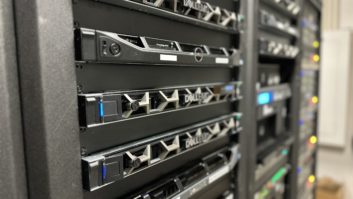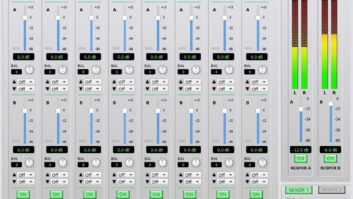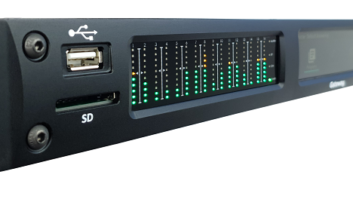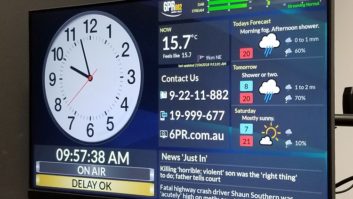The author is vice president of sales, support and marketing for the Telos Alliance.

The author says that AoIP facilities cost less, are faster to build, offer more flexible workflows and are more scalable.
Credit: iStockphoto/teekid New York Yankee Yogi Berra once said, “The future ain’t what it used to be.” Take that quote and apply it to Audio over Internet Protocol in broadcast facilities and other professional venues, and I’d have to say that Yogi would be wrong. The future is actually very bright indeed.
At Axia Audio — and the Telos Alliance at large — we were so convinced of the importance of interoperability between AoIP products that we put significant financial and technical resources into the work that led to the standard — AES67.
Until AES67 was ratified in 2013, the only AoIP interoperability was between hardware and software partners within a specific protocol, like our Livewire+. Then, as now, with 100 or so Livewire+ partners, our clients could share audio, data and GPIO between various pieces of AoIP gear in the thousands of studios where Axia consoles were installed.
Our competitors had some partners too, but the situation was not ideal because folks with AoIP equipment made by competing manufacturers were simply not able to take full advantage of the beauty of AoIP.
AES67 changed all that by defining how AoIP systems from various manufacturers share audio streams. It opened up the potential of a larger AoIP ecosystem, giving new and old users alike the benefits of large interoperable networks. Suddenly, any gear that complied with the AES-67 standard could share audio streams, paving the way for AoIP to become more mainstream.
This has been great for the industry, because with more manufacturers coming to the table, broadcasters have a wider choice of equipment.
However, broadcasters have always had the need to send “Start,” “Stop” and other control signals, along with the audio and program associated data. And while Livewire had the ability to share control information, some AoIP protocols did not.
AES-70
A page from the AES Standards News Blog sets out the three parts of “AES70-2015:AES standard for audio applications of networks – Open Control Architecture.” View it at www.aes.org/standards/. The latest standard, AES70, aims to fix that by co-existing with AES67 on the AoIP network and sharing control information (GPIO) across different AoIP gear. With AES70 in the mix, the broadcaster’s AoIP network can continually evolve and is essentially future-proof.

For the first time, thanks to the number of broadcast gear manufacturers that have adopted AoIP, broadcast facilities can be built from microphone to transmission processor (over the air or over the Internet) using nothing but Ethernet. Even speakers now have AoIP connectivity!
As I mentioned, the future is brilliant for AoIP, and we see 2016 as a banner year for the technology. Here are our predictions for what will be coming down the pipeline in the coming months:
More AoIP gear will become available — More manufacturers are embracing AoIP. We’re seeing this adoption across a number of other audio markets, such as live sound. In fact, Audinate has announced that its Dante AoIP standard will support AES67. The more choices for broadcasters, the better.
Increased promotion of AoIP — Through organizations like Media Networking Alliance (medianetworkingalliance.com) and the Alliance for IP Media Solutions (aimsalliance.com), forward-looking broadcast suppliers are investing real money to speed the adoption of AoIP through education and promotion. Telos Alliance is proud to be involved in both groups, because they are the best way to move AoIP forward.
Late adopters making the switch to AoIP for good — Those who said “no” in the early days are changing their tune. Customers are no longer buying older TDM designs, but are firmly in the AoIP camp. The vast majority of those we talk with will not buy or use anything but AoIP for their upcoming projects.
Differentiation of full AoIP vs. partial AoIP offerings — We see the industry becoming very savvy about networks that are fully open versus those that are partially open. Some providers only offer AoIP at the edges of their networks, while maintaining proprietary topologies at the core. In our experience, most want a fully open network that has Ethernet at its core. Additionally, this allows the core to be updated as time goes on — something that can’t be done with proprietary cores. One of our larger clients just did this with their core switch and were ecstatic with the results.
Whether you’re talking AES67 or AES70, one thing is certain: In the 10-plus years since the first AoIP studios were created with Axia consoles and gear, AoIP has lived up to every promise it has made. AoIP facilities cost less, are faster to build, offer more flexible workflows and are more scalable. AoIP is here to stay, and we’re excited to be a part of both its heritage and its future.
Comment on this or any story. Email[email protected]with “Letter to the Editor” in the subject field.












